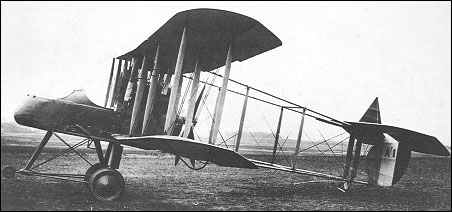|
| On 7 April 1916, a version of the F.E.2b was flown at the
RAF Farnborough, fitted with a 250hp Rolls-Royce Mk I
(later, Eagle I) 12-cylinder water-cooled V-type engine,
becoming thus the prototype F.E.2d. Compared with
the 160hp F.E.2b, the Rolls-Royce-engined version had
better rate of climb and ceiling and slightly improved
speed performance, and although the heavier engine
adversely affected manoeuvrability and field performance,
the F.E.2d was ordered into production as an
interim supplement for the F.E.2b. Eighty-five were
built at Farnborough and 270 by Boulton & Paul,
although many of these were completed, in the event,
with Beardmore engines as F.E.2b's. In those F.E.2d's
completed, several versions of the Rolls-Royce engine
were fitted; as well as the Mk I these comprised the
250hp Marks III and IV (later, 284hp Eagle III and IV)
and the 275hp Marks I and II (later, 322hp Eagle V and
VI). The first few F.E.2d's had the oleo undercarriage
with nosewheel extension, but the modified oleo type without the nosewheel was soon adopted. The F.E.2d
was in service in France by July 1916, and the type also
served with Home Defence units, although its low
speed performance made it an ineffective Zeppelinchaser.
Most F.E.2d's were armed with two Lewis
guns, one on a flexible mounting in the nose and
another fixed forward-firing for the pilot; in some cases
a third gun, on a telescopic pillar mounting, was also
provided between the two cockpits.
| MODEL | F.E.2d (with 250hp RR Mark I e |
| WEIGHTS |
| Take-off weight | 1574 kg | 3470 lb |
| Empty weight | 1138 kg | 2509 lb |
| DIMENSIONS |
| Wingspan | 14.55 m | 48 ft 9 in |
| Length | 10.13 m | 33 ft 3 in |
| Height | 3.85 m | 13 ft 8 in |
| Wing area | 45.89 m2 | 493.96 sq ft |
| PERFORMANCE |
| Max. speed | 151 km/h | 94 mph |
| Ceiling | 5334 m | 17500 ft |
| zifeng, 18.06.2011 10:38 Could a gunner /oberv. actually do something like this while in the air? What about "falling-out" fatalities reply | | "Bugs" Wirkus, e-mail, 25.09.2010 17:27 I have seen one photo of a gunner /observer standing and
facing backwards holding a Lewis mg---the picture was taken whils the aircraft was on the ground.
Could a gunner /oberv. actually do something like this while in the air? What about "falling-out" fatalities?
I am curious and thank all that might respond. Take Care :) reply | | "Bugs" Wirkus, e-mail, 25.09.2010 17:27 I have seen one photo of a gunner /observer standing and
facing backwards holding a Lewis mg---the picture was taken whils the aircraft was on the ground.
Could a gunner /oberv. actually do something like this while in the air? What about "falling-out" fatalities?
I am curious and thank all that might respond. Take Care :) reply |
|
Do you have any comments?
|
| 
COMPANY
PROFILE
All the World's Rotorcraft
|






